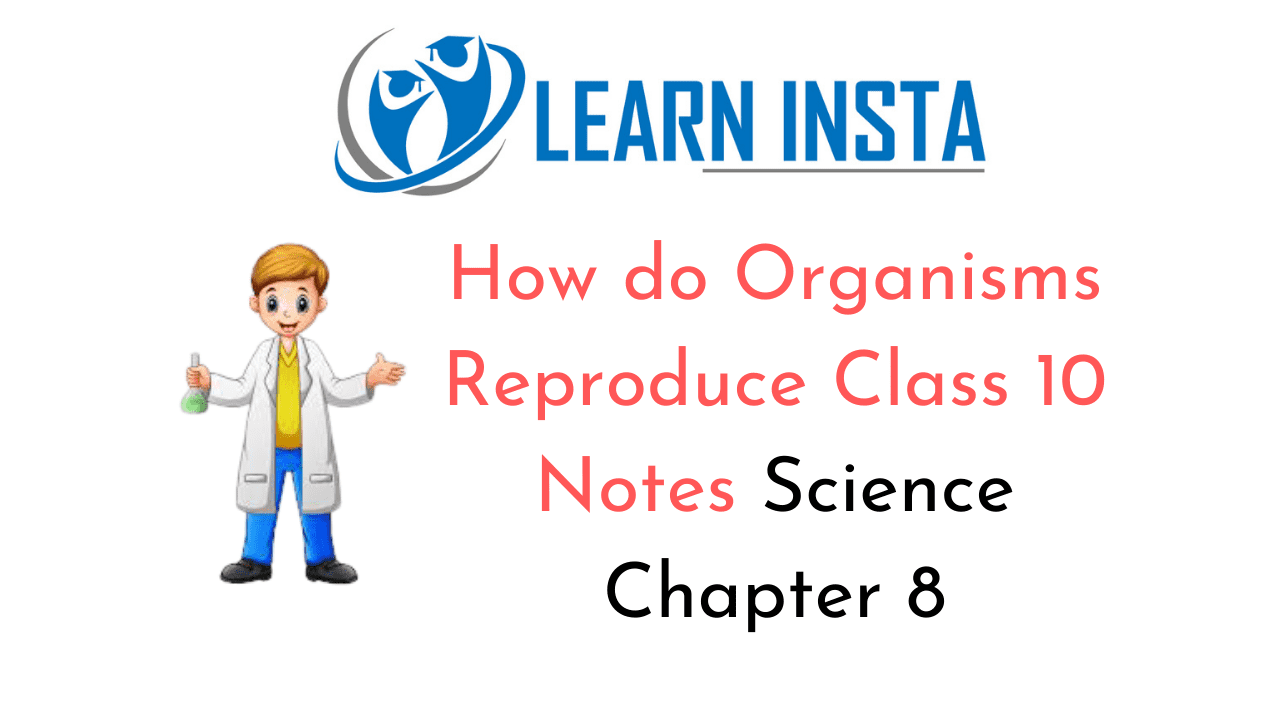 On this page, you will find How do Organisms Reproduce Class 10 Notes Science Chapter 8 Pdf free download. CBSE NCERT Class 10 Science Notes Chapter 8 How do Organisms Reproduce will seemingly help them to revise the important concepts in less time.
On this page, you will find How do Organisms Reproduce Class 10 Notes Science Chapter 8 Pdf free download. CBSE NCERT Class 10 Science Notes Chapter 8 How do Organisms Reproduce will seemingly help them to revise the important concepts in less time.
CBSE Class 10 Science Chapter 8 Notes How do Organisms Reproduce
How do Organisms Reproduce Class 10 Notes Understanding the Lesson
1. Reproduction: It is the process by which organisms produce their own kind.
2. Importance of Reproduction: Reproduction enables the continuity of the species, generation after generation.
3. Basic Event in Reproduction for transmission of hereditary information: Copying of DNA
(Deoxyribose Nucleic Acid) molecules present in the chromosomes of the cell.
4. DNA copying is accompanied by the creation of an additional cellular apparatus: As keeping one copy of DNA in the original cell and simply pushing the other one out would not work, because the copy pushed out would not have any organised cellular structure for maintaining life processes.
5. Importance of Variation: Process of copying the DNA is not completely accurate every time, so variations occur. The useful variations are retained while the harmful ones are eliminated. So, the variations enable the organism to survive under unfavourable conditions. This inbuilt tendency for variation during reproduction is the basis for evolution.
6. Difference between Sexual reproduction and Asexual Reproduction
| Asexual Reproduction | Sexual Reproduction |
| Single parent is involved. | Two parents are involved. |
| No fusion of gametes. | Fusion of gametes occurs. |
| Progeny is genetically identical to the parent. For example, Fission in Amoeba | Variations occur in the progeny. For example, Human beings |
6. Different Types of Asexual Reproduction
Fission
- Binary fission: The parent cell divides/splits equally into two daughter cells. For example, Amoeba
- Multiple fission: The parent cell splits into many cells. For example, Plasmodium (Malarial parasite)
- Binary fission: The splitting of the two cells into two equal halves during division can take place in any plane; it occurs in Amoeba.
Binary fission in Leishmania (which cause kala-azar), occurs in definite orientation/plane due to presence of whip-like structure at one of the cell

7. Fragmentation:
The process by which the broken pieces of an organism (fragments) grow into a complete organism. For example, Spirogyra
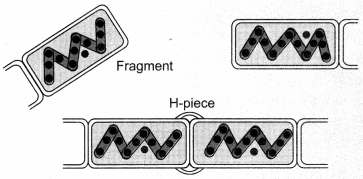
8. Regeneration: Some simple animals can develop into a new individual from their broken older parts by a process called regeneration. For example, Planaria, Hydra, Starfish.
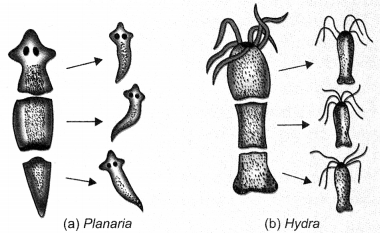
9. Budding: In this process a new organism is produced as an outgrowth of the parent body part. For example, Hydra, Yeast.
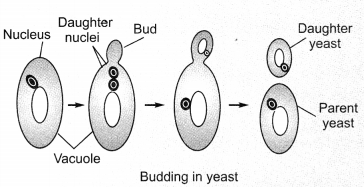
10. Spore Formation: Small, bulb-like structures called spores develop at the top of the erect hyphae of the fungus. Spores released into the air, germinate into new individuals
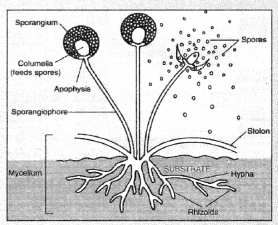
11. Vegetative Propagation: A mode of reproduction in which the vegetative parts of the plant like the stem, root and leaves develop into new plant under favourable conditions.
Advantages of Vegetative Propagation
- Plants can bear flowers, fruits earlier than those produced from seeds.
- Enables us to grow banana, orange, rose, jasmine that have lost the capacity to produce seeds.
- Maintains genetical similarity in the plants.
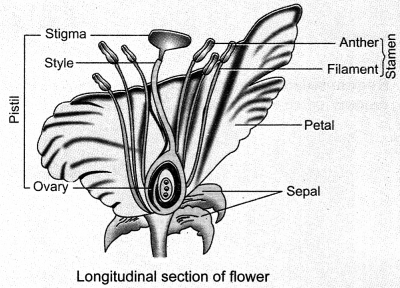
Example: Layering or grafting done in sugarcane, rose and grapes; buds produced in the notches along the leaf margin of Bryophyllum which fall on the soil and develop into new plants.
Disadvantages of Vegetative Propagation
- Plants gradually lose their genetic variation.
- Since many plants are produced, it results in overcrowding and lack of nutrients.
12. Tissue culture: In this technique, the cells removed from the tip of the plant are placed in an artificial medium where they divide rapidly to form a small group of cells or callus which forms plantlets when placed in a medium containing hormones for growth and differentiation. The plantlets are then placed in the soil to grow into mature plants. This technique can be used to obtain disease free plants from virus infected plants.
13. Sexual Reproduction
The process of sexual reproduction involves the fusion of gametes called fertilisation. During sexual reproduction, exchange of chromosomal (genetic) fragments between homologous chromosomes occur causing genetic recombination which leads to variation.
14. Sexual Reproduction in Flowering Plants Stamen: Male reproductive part of the flower made of filament and anther. Pollen grains are produced inside anthers.
Carpel: Female reproductive part of the flower made of three parts—Stigma, style and ovary. Ovules are present inside ovary.
16. Types of flowers
- Unisexual flowers: Flowers bear either stamen or carpel. For example, papaya and Watermelon.
- Bisexual flower: Flowers bear both stamen and carpel. Example: Hibiscus, Mustard.
- Pollination: The transfer of pollen grains from the anther to the stigma of a flower. The transfer occurs by agents like wind, water or animals.
17. Types of pollination
(i) Self-pollination: Transfer of pollen grains to the stigma of the same flower.
(ii) Cross-pollination: Transfer of pollen grains to the stigma of another flower.
The ovary contains ovules and each ovule has an egg cell. After the pollen lands on a suitable stigma, a pollen tube grows out of the pollen grain which bears male germ cells and travels through the style to reach the ovary. Male germ cells reach female gamete and fuse with it by process of fertilisation to form zygote. The zygote divides several times to form an embryo within the ovule. The ovule develops a tough coat and is converted into a seed which forms a seedling/new plant by the process of seed germination. Ovary develops into fruit. Ovules develop into seed. Petals, sepals, stamens, style and stigma may shrivel and fall off in most cases but sepals may persist in the case of brinjal, tomato, etc.
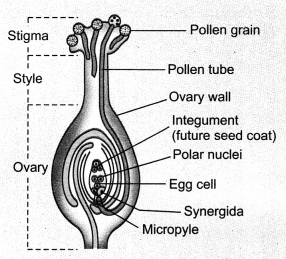
18. Reproduction in Human Beings: Humans use a sexual mode of reproduction. The period when the reproductive organs become mature and functional in humans is called puberty. Many changes occur during puberty:
19. Changes common to both boys and girls: Thick hair growing in armpits and the genital area between the thighs; Thinner hair appear on legs, arms and on the face; skin frequently becomes oily and might begin to develop pimples.
Changes different in boys and girls: In girls, breast size begins to increase, with darkening of the skin of the nipples at the tips of the breasts. Girls begin to menstruate at around this time.
Boys begin to have new thick hair growth on the face and Seminal vesicle their voices begin to crack. The penis occasionally begins to become enlarged and erect, either in daydreams or at night.
20. Male Reproductive System
The male germ cells (sperms) are formed in a pair of testes (male reproductive organ) which are located inside scrotum situated outside the abdominal cavity. It helps to keep relatively a low temperature needed for the production of sperms by testes.
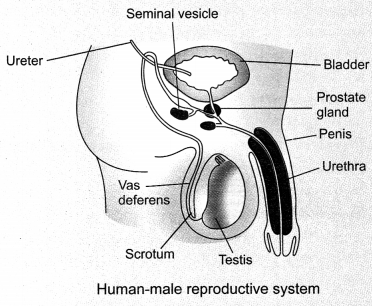
Testes release a male sex hormone called testosterone whose function is to:
- Regulate the formation of sperms.
- Bring about changes in appearance seen in boys at the time of puberty.
The sperms formed in testes are delivered through the vas deferens which unites with a tube coming from the urinary bladder. Urethra is a common passage for both the sperms and urine. Glands like the prostate and the seminal vesicles add their secretions to make transport of sperms easier and provide nutrition to them.
21. Female Reproductive System
The female germ-cells or eggs are made in the ovaries. Some hormones are formed inside ovaries. Thousands of immature eggs are already present in the ovary of a newly born girl which start maturing on reaching puberty. Every month one egg produced by one of the ovaries is carried from the ovary to the womb through a thin oviduct or fallopian tube. The two oviducts unite into an elastic bag-like structure known as the uterus which opens into the vagina through the cervix.
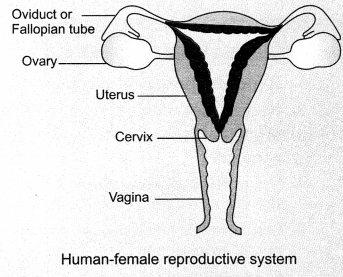
23. Fertilisation: During sexual intercourse the sperms enter through the vaginal passage, travel upwards and reach the oviduct where they may fertilise the egg to form zygote. The process of fusion of male and female gamete to form a zygote is called as fertilisation. The zygote formed gets implanted in the lining of the uterus, and starts dividing. The uterus prepares itself every month to receive and nurture the growing embryo. The lining thickens and is richly supplied with blood to nourish the growing embryo.
24. Placenta and its functions: A disc shaped structure embedded in the uterine wall called the placenta provides nutrition to the embryo from the mother’s blood. It contains villi on the embryo’s side of the tissue which are surrounded by blood spaces on the mother’s side.
Following are the roles of placenta:
- It provides a large surface area for glucose and oxygen to pass from the mother to the embryo.
- It removes waste substances produced by the developing embryo.
25. Gestation Period: The development of the child inside the mother’s body takes approximately nine months. This period is called as gestation period. The child is born as a result of rhythmic contractions of the muscles in the uterus.
26. Fate of Unfertilised egg: The ovary releases one egg every month, the lining of the uterus becomes thick and spongy every month to receive a fertilised egg and nourish the embryo. If the egg is not fertilised, it lives for about one day. But if it remains unfertilised then the lining of the uterus slowly breaks and comes out through the vagina as blood and mucous. This cycle is called menstruation which takes place every month and lasts for about two to eight days.
27. Menopause: The sexual cycle in a woman continues upto the age of 45 to 50 years after which eggs are not released by the ovary and menstruation gets stopped. This stage is called Menopause.
28. Reproductive Health: The total well-being in all aspects of reproduction, i.e., physical emotional, social and behavioural is called reproductive health.
29. Sexually transmitted diseases: Bacterial infections like gonorrhoea and syphilis; viral infections like warts and HIV-AIDS. Transmission of many sexually transmitted diseases can be prevented by condoms.
30. Contraceptive methods: The methods to avoid pregnancy are called as contraceptive methods. The different methods are:
Physical methods: Prevent union of sperm and egg. For example, condoms, diaphragm and cervical caps Chemical methods: Act by changing the hormonal balance of the body so, that eggs are not released and fertilisation cannot occur. They may have side-effects too.
For example, Oral pills Surgical methods:
- Vasectomy: The vas deferens of male is blocked to prevent sperm transfer.
- Tubectomy: The fallopian tube of female is blocked to prevent egg to reach uterus.
- Copper-T or loop is placed in uterus to prevent pregnancy.
31. Pre-natal sex determination: The determination of the sex of the child before birth is called as pre-natal sex determination. It is prohibited by law as it is a major cause of illegal sex-selective abortion of female foetuses. The female-male sex ratio must be maintained for a reproductively healthy society.
Class 10 Science Chapter 8 Notes Important Terms
Reproduction: It is the process by which organisms produce their own kind.
Binary Fission: The parent cell divides/splits equally into two daughter cells. For example, Amoeba
Multiple Fission: The parent cell splits, into many cells. For example, Plasmodium (Malarial parasite)
Vegetative Propagation: A mode of reproduction in which the vegetative parts of the plant like the stem, root and leaves develop into new plant under favourable conditions.
Statement: Male reproductive part of the flower made of filament and anther. Pollen grains are produced inside anthers.
Carpel: Female reproductive part of the flower made of three parts stigma, style and ovary.
Pollination: The transfer of pollen grains from the anther to stigma of a flower.
Testosterone: Male sex hormone released by the testes.
Estrogen and Progesterone: These are the sex hormones released by the ovaries in the human females.
Placenta: A disc shaped structure embedded in the uterine wall which provides nutrition to the embryo from the mother’s blood.
Menopause: The sexual cycle in a woman continues upto the age of 45 to 50 years after which eggs are not released by the ovary and menstruation stops. This stage is called Menopause.
Contraceptive Methods: The methods to avoid pregnancy are called as contraceptive methods.
Vasectomy: The process by which the vas deferens of male is blocked to prevent sperm transfer.
Tubectomy: The process by which the fallopian tube of female is blocked to prevent egg to reach the uterus.
Pre-natal sex determination: The determination of the sex of the child before birth is called pre-natal sex determination.